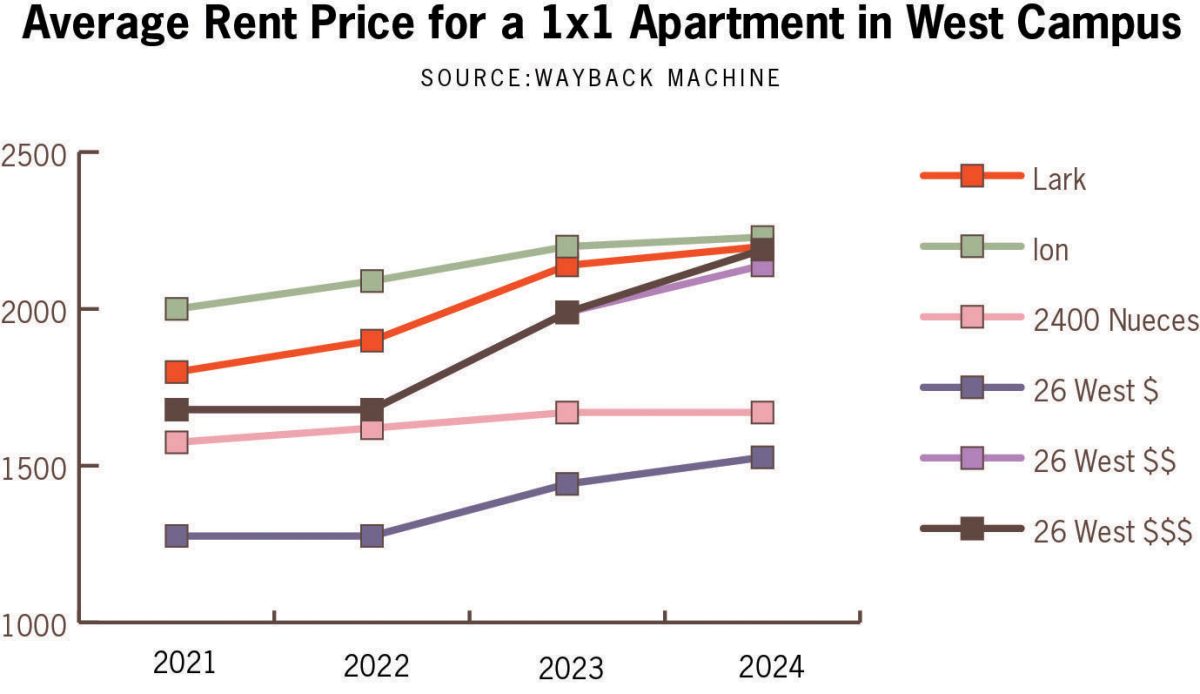Austin rent has declined steadily over the past year, but The Daily Texan found rates for one-bedroom apartments in West Campus are 65% higher than Austin’s median cost.
A rental report found the median rate has decreased by 1.3% in the past month alone, while rent in West Campus remains high. Several companies moved to Austin during the pandemic, bringing new people and driving up rent prices, said Jake Wegmann, a faculty member in community and regional planning at the School of Architecture. A subsequent influx of apartment projects created a housing surplus, he said.
“There’s so much competition for renters that a lot of these apartment developments are forced to drop their rents, and that’s what you’re seeing in the data,” Wegmann said. “(Austin) is one of the metros that has probably experienced the biggest drop in rents over the past year.”
The median rate for a one-bedroom apartment in Austin is $1,309, according to the rental report. Based on a sample of four commercial apartments done by The Daily Texan, 26 West, 2400 Nueces, Lark and Ion For West Campus, students pay about $2,164 for the same unit.
Computer science alumnus Ben Aubin lives in a 2-bedroom, 2-bathroom unit at Ion. He said the apartment’s amenities and proximity to campus made it appealing. “I thought (the price) was pretty fair,” Aubin said “It was definitely shockingly (pricey), but most of the West Campus apartments were.”
After living there for two years, however, Aubin’s rent increased by about $200.
“The apartments are probably able to get students to pay more than they otherwise would because they use (high-pressure) sales tactics,” Aubin said. “They aren’t expecting students to shop around much.”
Wegmann said it’s possible a considerable amount of housing in West Campus was vacant during the pandemic. Students quickly started filling apartments after in-person classes resumed, which could have indirectly caused a “rebound effect.”
Edwin Bautista, a community and regional planning alumnus, came to UT as a first-generation student. He said he did not have a lot of support and heavily relied on financial aid for rent.
“I was paying $746 for a bedroom and a bathroom in a four-bedroom, three-bath unit (at Skylark),” Bautista said. “My rate increased to $928 … this is supposed to be affordable housing, but how is it affordable if you see rates (increasing)?”
Safe, Mixed-Income, Accessible, Reasonably-Priced, Transit-Oriented Housing, which students like Bautista rely on, is designed to provide accessible housing for low and moderate-income Austin residents. Under this, developments must have a minimum number of affordable units, satisfy requirements related to proximity to transit and meet certain accessibility standards.
Bautista said he almost dropped out of college before he had S.M.A.R.T. Housing because of his housing instability. According to the Statesman, students paid about $13,000 in housing costs in 2023, exceeding the average yearly tuition cost.
Isabel Webb Carey, the founder of UT Housing Transparency, a platform that educates students about housing affordability, said providing housing information and students understanding tenant rights is critical.
“(UT), in my opinion, has a duty to its students, to the educational and holistic development of students. … We are not going to be served if we are struggling to pay rent,” Carey said. “We’re students. We’re here to learn, not here to wonder how we’re going to make ends meet.”















